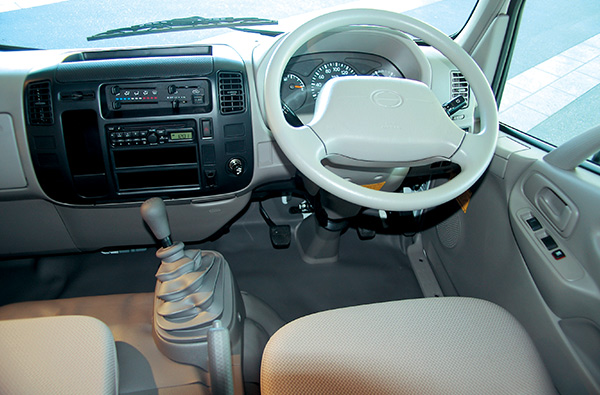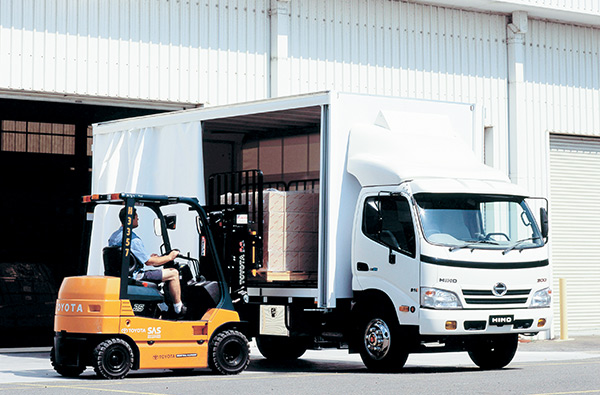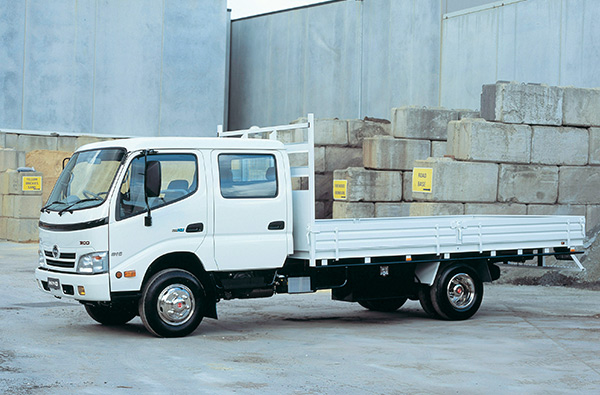Hino has launched an aggressive attack on the small and medium truck market with the new 300 Series, which delivers a host of new technology features. Pete Armstrong reports
Armed with a new management structure and a raft of new models, Hino Motors Australia is aiming to knock Isuzu from the number-one position in the light and medium truck markets as well as increase its share of the heavy truck segment by 2010.
A decade on from when it first formed a local subsidiary, and 40 years since initially entering the market, the Japanese group has appointed a new leadership team — including Toyota Australia Executive Chairman John Conomos as Chair and Steve Lotter as Chief Executive — to lead the charge.
The new management team is armed with some powerful ammunition to take into battle in the hotly contested truck sales war.
Its first round of ammunition is the new 300 Series light-duty range, which replaces the Dutro.
With 19 variants, including a crew cab, there is plenty in the offing and technology incorporated into the vehicles will make others sit up and take notice.
Hino has a new independent front suspension (IFS) with double wishbone and rack-and-pinion steering. The coil-spring suspension has been developed for more comfortable ride, better steering and stability.
Those working on rough roads are offered a rigid front suspension known as the ‘Lo Pro’ for stability under these conditions.
None of the safety requirements have been overlooked and the 300 comes standard with ABS and electronic brake-force distribution (EBS).
On all but one variant, four-wheel disc brakes with ventilated discs and dual piston callipers are now fitted.
Engine
There is a new 4-litre common-rail turbo-diesel engine under the cab, with ratings of 102 and 114kW, meeting US 04 and ADR80/1 emissions up front. This is achieved through electronically controlled and water-cooled exhaust gas recirculation (EGR) technology.
Hino is also the first at the lighter end of the truck market to introduce EGR technology into its diesel engines. It uses a variable-nozzle turbo to maximise engine response and torque through faster build up of pressure in the turbocharger housing.
The 4-litre engine replaces the 4.6-litre powerhouse previously used in the Dutro line up, with a resultant improvement in power, torque and fuel consumption over its predecessor.
Six 300 Series standard-cab models have 1-3kW of power at 2700rpm and 364Nm of torque at 1800rpm. The 13 wide-cab models feature 114kW at 2700 with 404Nm or torque at 1800rpm.
Transmission
New transmissions are also a part of the package and now Hino offers a six-speed full automatic in three models.
The intelligent automatic has fuel-saving torque converter lockup in five ratios from second to sixth gear. The transmission adapts to driving style and a ‘neutral control’ switches to neutral when the truck has been stationary for some time with the brakes applied, reducing engine and driveline load that impact on fuel consumption.
When it comes to manual transmissions Hino has developed what it calls ‘Easy Start’ technology. This has been designed for hill starts and the driver activates a toggle switch on the dash. When stopped on a hill the technology applies the brake, even when the foot is lifted off the pedal, and once the throttle is depressed and the vehicle is on its way it releases the brakes for easy lift off with no roll back and again decreases the load on the driveline.
Cab and Controls
Standard cab models have a driver’s side airbag while wide cabs offer one for driver and passenger.
Another safety feature is cornering headlamps, activated when the indicators are operating, giving better illumination during night driving.
In response to customer demand, Hino has introduced a seven-seat crew cab model in the 300 Series.
The truck has a GVM of 7,500 kilograms and a GVM of 11,000 kilograms, and with dual compliance, as are 16 models, can be driven on a car licence.
Comfort levels have been upgraded over the Dutro trucks and now larger cab mounts further reduce road shock from the cab and increased thickness in the spring leaves deliver a better ride.
Add air-conditioning, keyless entry, power windows and tilt and telescopic steering wheel, and it’s a car-like package.
To make a delivery driver’s life that bit more comfortable interior fitments include a sun visor on the passenger side, fluro cab lamp, pull-up window switches, large overhead console, centre seat console, door pocket, dash console in the wide-cab variants, pen stand with hook and even a card holder mounted in the dash.
As if there weren’t enough standard features thrown in, the 300 Series also includes pull-out cup holders, coat hanger, coin holder, in-cab headlight adjustment, halogen headlights and fog lamps.
Performance
For a small truck, the equipment and fittings are impressive, but the real test comes when the vehicle is on the road.
Unfortunately, it was not possible to put all trucks in the 300 line up through their paces, but a return drive from Port Melbourne to Dandenong gave a good first impression.
Most scoff at going to a smaller engine in any truck but technology improvements continue to deliver not only improved driving capability but better overall power and road manners.
The Hino 300 Series impressed firstly with its braking, almost immediately after leaving the start point. As with all Japanese trucks engine braking is very good but depressing the foot pedal revealed a better-than-expected result.
The four-wheel disc brakes are superb, with positive, progressive and smooth stopping power.
Considering the majority of 300 Series trucks will undoubtedly spend their life in city and urban delivery roles, every driver will find this faultless and a considerable safety enhancement.
The first drive was in a five-speed manual transmission model and in a very car-like manner the small truck took to the task with short and smooth shifting keeping pace with the traffic effortlessly.
One thing a driver requires is a quiet work environment and the 300 doesn’t disappoint, even at high engine revs while powering away. The noisiest thing about the truck was when the fan cut in, and that could not be described as being unacceptable — in fact, it is far from it.
Stability and handling too is excellent and pushing the little 300 around town though all traffic conditions was pleasurable.
Hino has a single-wheel model available for tradesmen and the like who require more payload space, and one can imagine the small Hino will find a number of sales in this sector due to its metropolitan area agility.
Performance is delivered with little throttle working the very responsive engine under the cab, and even with a full load there was nothing the road traffic conditions could do to slow it down.
Point A to point B travel is as quick as traffic will allow and small truck operators might find some surprises in this performance.
The ‘Easy Start’ feature was put to the test on a steep incline at Hallam in Melbourne’s east, and many will appreciate the simplicity of the system that will ultimately deliver fewer maintenance problems due to overzealous use of throttle and clutch on hill starts.
Coming to a halt and the switch was activated, although it is possible to leave it in the on position at all times. With the foot firmly on the brake the computer takes over and then lifting the foot, with no handbrake applied, the truck goes nowhere.
With the throttle depressed and the clutch released the truck simply takes off and, just to make the system more useful, it works in both forward and reverse and at two speeds.
Drive two was in a wide cab fitted with the new automatic six-speed transmission and this is one variant that will attract many due to its driving simplicity. The gear selection lever is dash-mounted and a simple depress of the button, with drive selected, one might as well be piloting the family hack rather operating a truck.
The auto features rapid changes depending on power needs and shifts through the gears with no indication of its operation.
In the heavily-trafficked Dandenong area and onto the freeway back to Melbourne it was easy to see lazy drivers will be more than accommodated.
The life of a delivery driver has been made so much simpler, and while automated manual transmissions are proving very popular, this Hino fully automatic box will no doubt gain a league of followers.
The model range is available now and Dutro is a chapter passed. When possible we will put some of the variants to the test in work roles to gauge proper performance and economy in what is a highly competitive and tough side of the business.
Verdict
The Hino 300 Series range is step to the future and breaks new ground in the small truck sector, with features competitors will be sure to follow.
It would be fair to say Hino has upped the ante in this part of the truck market and, as mentioned earlier, there is more to come.
The Hino brand might have 40 years’ experience in the Australian road transport industry but this is the start of a new era. The competition just got tougher.
Specifications
Engine: Hino NC04C TV ADR 80/01
Max output: 114kW (155PS) at 2700rpm
Max torque: 404Nm at 1800rpm
Type: Diesel, 4 cycle, 4-cylinder in line, overhead valve, water cooled
Combustion system: Direct injection type
Bore & stroke: 104 x 118mm
Piston displacement: 4.009 litres
Fuel injection system: Electronic control, common rail type
Air intake system: Turbo-intercooled, stack-type air intake
Air cleaner: Paper element
Fan clutch: equipped





